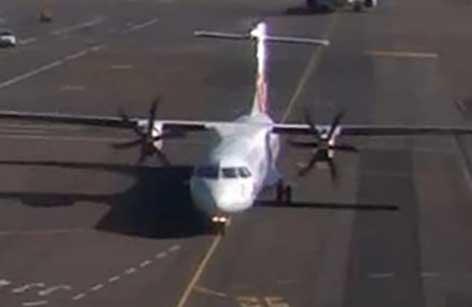The Australian Transport Safety Bureau has issued Safety Recommendations to the European Aviation Safety Agency (EASA) and aircraft manufacturer ATR seeking improved aircraft system design tolerance to inadvertent dual control inputs by pilots.

The Safety Recommendations are contained in the ATSB’s final investigation report into an inflight upset and inadvertent pitch disconnect experienced by an ATR 72 turboprop airliner on a flight from Canberra to Sydney in 2014.
During that flight, as a result of a sudden decrease in tailwind, the ATR’s pilots unintentionally applied opposing control inputs to their control columns while trying to ensure the aircraft remained below its maximum operating speed. These differential forces activated the aircraft’s pitch uncoupling mechanism. Intended for activation in the event of one of the aircraft elevators being jammed, the pitch uncoupling mechanism resulted in a pitch disconnect, where the elevators could operate independently of each other.
With the pilots applying opposing control inputs and built-up tension within the flight control system, the pitch disconnect resulted in transient asymmetric elevator deflections, generating aerodynamic loads that exceeded the strength of the horizontal stabiliser (tailplane), causing significant damage.
The aircraft landed safely and was inspected by maintenance engineers but the damage was not detected. The aircraft returned to service and operated a further 13 flights before a subsequent inspection after a suspected birdstrike found it had sustained serious structural damage to its horizontal stabiliser, which was subsequently replaced.
Discovery of that damage was the catalyst for one of the ATSB’s most complex, thorough and protracted safety investigations.
Through the release of two interim reports, the investigation has already seen the aircraft manufacturer, aircraft operator and aircraft maintenance provider address a number of safety issues identified by the ATSB.
However, as part of its final report, the ATSB has issued a Safety Recommendation to EASA, recommending taking “further action to review the current design standard (CS-25) in consideration of effect that dual control inputs may have on control of aircraft.”
In addition, the ATSB has issued two Safety Recommendations to aircraft manufacturer ATR, recommending that ATR:
- assess the operational risk associated with limited tactile feedback between left and right control columns in the context of no visual or auditory systems to indicate dual control inputs; and
- perform a detailed review of the effects of dual control inputs on the aircraft’s longitudinal handling qualities and control dynamics to determine if there are any detrimental effects that could lead to difficulty in controlling the aircraft throughout the approved flight envelope and operational range.
“What this report seeks to achieve is to influence further incremental safety improvements,” ATSB Chief Commissioner Greg Hood said.
Aircraft and aircraft systems need to be designed in anticipation of and tolerant to foreseeable inadvertent flight crew actions.
“This serious incident demonstrates aircraft and aircraft systems need to be designed in anticipation of and tolerant to foreseeable inadvertent pilot actions.
“Further, when identified, aviation safety regulators and aircraft manufacturers need to address previously unforeseen aircraft design consequences during the operational life of an aircraft type.”
Mr Hood said the investigation also highlights the importance of a full and proper inspection to detect aircraft damage and the need for the inspection to be fit for purpose and for inspections to be coordinated and certified to avoid a single point failure.
“The ATSB looks forward to EASA’s and ATR’s responses to our Safety Recommendation from this investigation.”


